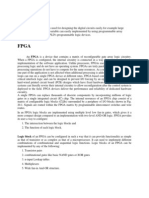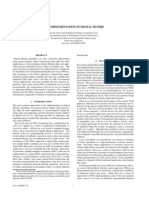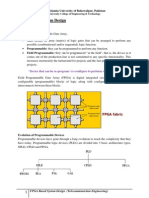Implementing VHDL Code On Fpga
Uploaded by
visheshImplementing VHDL Code On Fpga
Uploaded by
visheshIMPLEMENTING VHDL CODE ON FPGA
ABSTRACT
The principle of an automatic VHDL code generator dedicated to the control of the electric systems is
presented in this paper. From the definition of classic regulator, it is possible to envisage a direct integration
of the digital regulator in a FPGA component. The advantage of using a FPGA rather than a micro-controller
lies in the fact of reaching very high sampling frequencies, allowing to obtain better performances with
important bandwidths. It can be then considered that the digital regulator works in a quasi-analog mode.
Experimental results are obtained for a Direct Current Power Flow Control (DCPFC) application to prove
the better overall performance. A field-programmable gate array (FPGA) is an integrated circuit designed to
be configured by a customer or a designer after manufacturing hence "field-programmable". The FPGA
configuration is generally specified using a hardware description language (HDL), similar to that used for an
application-specific integrated circuit (ASIC) (circuit diagrams were previously used to specify the
configuration, as they were for ASICs, but this is increasingly rare).
Contemporary FPGAs have large resources of logic gates and RAM blocks to implement complex digital
computations. As FPGA designs employ very fast I/Os and bidirectional data buses it becomes a challenge to
verify correct timing of valid data within setup time and hold time. Floor planning enables resources
allocation within FPGA to meet these time constraints. FPGAs can be used to implement any logical
function that an ASIC could perform. The ability to update the functionality after shipping, partial reconfiguration of a portion of the design and the low non-recurring engineering costs relative to an ASIC
design (notwithstanding the generally higher unit cost), offer advantages for many applications.
FPGAs contain programmable logic components called "logic blocks", and a hierarchy of reconfigurable
interconnects that allow the blocks to be "wired together" somewhat like many (changeable) logic gates
that can be inter-wired in (many) different configurations. Logic blocks can be configured to perform
complex combinational functions, or merely simple logic gates like AND and XOR. In most FPGAs, the
logic blocks also include memory elements, which may be simple flip-flops or more complete blocks of
memory.
SOFTWARE USED:
Xilinx ISE
SUBMITTED BY:
VIDUSHI GUPTA (2311236)
You might also like
- Complex Programmable Logic Devices (CPLD) & Field-Programmable Gate Array (Fpga)No ratings yetComplex Programmable Logic Devices (CPLD) & Field-Programmable Gate Array (Fpga)29 pages
- How To Program, Architecture, and Applications of Lattice FPGANo ratings yetHow To Program, Architecture, and Applications of Lattice FPGA23 pages
- Field-Programmable Gate ..., The Free EncyclopediaNo ratings yetField-Programmable Gate ..., The Free Encyclopedia14 pages
- Atul K Srivastava: 10.3 Field Programmable Gate ArraysNo ratings yetAtul K Srivastava: 10.3 Field Programmable Gate Arrays4 pages
- FPGA and FPGAC (High Level Synthesise Tools)No ratings yetFPGA and FPGAC (High Level Synthesise Tools)15 pages
- Definition:: Field-Programmable Gate ArrayNo ratings yetDefinition:: Field-Programmable Gate Array6 pages
- Field-Programmable Gate Array - Wikipedia, The Free EncyclopediaNo ratings yetField-Programmable Gate Array - Wikipedia, The Free Encyclopedia12 pages
- FPGA Based Systems:: Radha R C, Dept of ECE, BMSCENo ratings yetFPGA Based Systems:: Radha R C, Dept of ECE, BMSCE24 pages
- Introduction To Field Programmable Gate Arrays (Fpgas)No ratings yetIntroduction To Field Programmable Gate Arrays (Fpgas)8 pages
- Efficient Implementation of Scan Register Insertion On Integer Arithmetic Cores For FpgasNo ratings yetEfficient Implementation of Scan Register Insertion On Integer Arithmetic Cores For Fpgas6 pages
- FPGA Interview Questions, FPGA Interview Questions & Answers, FPGANo ratings yetFPGA Interview Questions, FPGA Interview Questions & Answers, FPGA9 pages
- An Introduction To How FPGA Programming WorksNo ratings yetAn Introduction To How FPGA Programming Works12 pages
- The Features of RISC Architecture That Support Pipelining Are Listed in Table 1No ratings yetThe Features of RISC Architecture That Support Pipelining Are Listed in Table 14 pages
- Dynamic Partial Reconfiguration in FpgasNo ratings yetDynamic Partial Reconfiguration in Fpgas4 pages
- PLC: Programmable Logic Controller – Arktika.: EXPERIMENTAL PRODUCT BASED ON CPLD.From EverandPLC: Programmable Logic Controller – Arktika.: EXPERIMENTAL PRODUCT BASED ON CPLD.No ratings yet
- Versatile Routing and Services with BGP: Understanding and Implementing BGP in SR-OSFrom EverandVersatile Routing and Services with BGP: Understanding and Implementing BGP in SR-OSNo ratings yet



























































